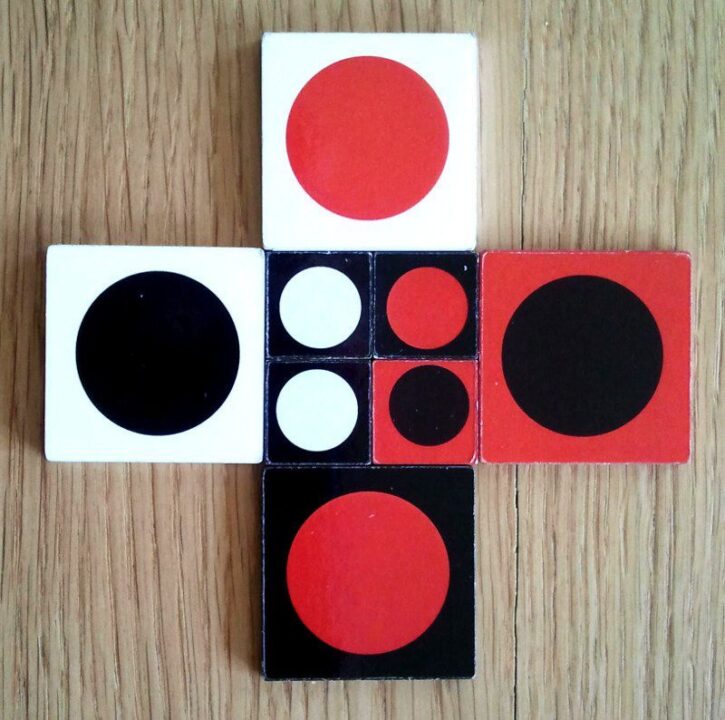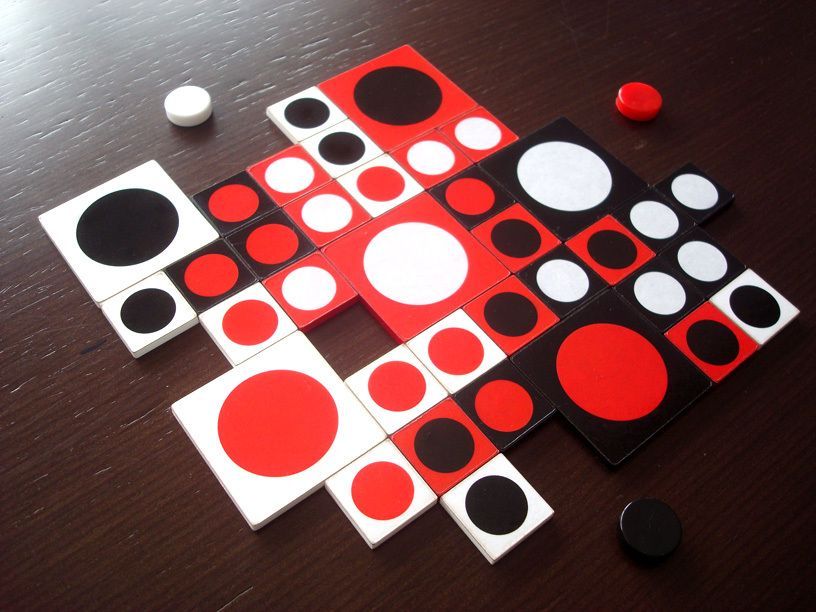It’s time for another review, and this one’s all about Red. If you’ve ever wanted a game that’s both easy to pick up and sneaky enough to make your friends question your morality, you’re in the right place! I’ve played this one several times now—sometimes stone-cold sober and once after questionable amounts of energy drink—so I feel ready to give you the honest lowdown. Spoiler: no weird, unfair rules here, and your fate isn’t just in the hands of the board game gods either. Let’s see if Red is worth a spot on your shelf, or if it’s just another, well, red herring.
How It Plays
Setting up
Set the deck face down in the middle of the table. Give each player a hand of seven cards. Place one card face up next to the deck to start the discard pile. That’s it, you’re ready to go.
Gameplay
On your turn, play a card from your hand to the discard pile. The card you play must match the color or number of the top card, or use a special action card to shake things up. Can’t play? Draw a card. If you still can’t go, your turn ends. A lot of groaning is normal here.
Winning the game
The first player to get rid of all their cards wins. If you forget to yell “Red!” when you’re down to your last card, you have to pick up two more. Yes, your friends will laugh at you. Don’t say I didn’t warn you.
Want to know more? Read our extensive strategy guide for RED.
Easy Rules, Clever Game: How Red Keeps it Simple
Let me start off by saying I have a true love-hate relationship with board game rulebooks. Sometimes they make me feel like I need a law degree just to figure out how to win a single round. But with Red, thank the gaming gods, things are light and breezy. The rules are so clear that even my cousin Tim, who once tried to win at chess by using Uno cards, managed to understand them in five minutes.
Each player in Red starts with a small hand of colorful cards. The main rule? Your card in play must be the highest in the color that’s currently the lead. That’s literally it. No fiddly exceptions or wild tokens. No “remember to subtract three unless it’s Tuesday”. You know those games where half the fun is explaining the rules? Red skips all that and lets you jump straight to actual fun. Honestly, this saved my game night—my group usually spends longer arguing about rules than playing, but with Red, we were shuffling and laughing before the chips made it out of the bag.
What really grabbed me was how this simplicity hides some sneaky strategy. Don’t be fooled by the easy-to-learn rules! The game gives just enough room for clever choices, without needing a spreadsheet to keep track. You’ll be making interesting, real decisions from your very first turn. My only gripe: if you’re the kind of player who enjoys drowning in complex rule interactions, Red might feel a tad too basic for your taste. But honestly, that was a relief for us.
So, if you like games that get going fast and don’t leave you scratching your head (or flipping the table), Red nails it. But can Red keep us all glued to the table once the cards are dealt? Buckle up, because next, I’m talking player interaction—and trust me, it gets loud!

Player Interaction and Engagement in Red
If you’re sick of games where everyone plays in their own little world, then Red might just be your salvation. This game is all about eyeballing your friends, making sneaky moves, and occasionally throwing a wrench into someone’s master plan. I played Red with my usual group, and let me tell you, it got LOUD. There was more table talk than an all-you-can-eat pasta dinner.
What keeps players glued to the table in Red is how constant the engagement is. There’s no waiting around while someone has their ‘epic moment.’ Every turn, you’re forced to deal with what other people have just done. You have to keep an eye on everyone’s play area, and sometimes you even have to change your whole approach because Karen, who usually plays it safe, suddenly turns into a wild card. It’s like musical chairs, but with more glaring.
We found ourselves second-guessing every play. Bluffing and the occasional misdirection are all over the place. Once, my friend Dave pretended to forget the rules to throw us off, but then he won with a sneaky combo. There’s also a lot of negotiation and a bit of light-hearted trolling. If you like social games where you can get inside each others’ heads, Red is a good pick.
So, in Red, there’s never a dull moment, and if you crave player interaction, you’ll get your fill and then some. If you want to find out whether skill or plain old luck wins the day, stick with me—next up is the age-old ‘strategy versus luck’ showdown!
Balancing Strategy and Luck in Red: Who Really Wins?
Look, I won’t lie—board games that make you feel like you’re at the mercy of the universe drive me nuts. Thankfully, Red does a decent job giving players some control. You can actually plan ahead, which makes me feel smart for once. The game isn’t just, ‘hey, roll this dice and pray you get a six!’ Instead, Red gives you choices. You have to watch what your pals do, and sometimes you’ll feel like a genius…right before it all falls apart because someone else spotted your plan.
But let’s get real—there’s still a bit of luck baking in. Sometimes you play the perfect card, and your friend ruins you with a random move. My buddy Greg once won because he drew the one card that saved his skin, and I’m still salty about it. That said, the game leans more toward skill than rolling the dice. Players who pay attention and plan smart plays usually end up ahead. If you’re like me and hate feeling cheated by luck, Red won’t drive you crazy, but it’s not totally luck-free. I’d say it strikes a fair balance: a dollop of chaos and a load of strategy.
This blend means Red keeps everyone on their toes, but it also rewards folks who think ahead and adapt. I respect a game that lets me blame my losses on my own bad decisions, not a cursed deck or a dice gone rogue.
Ready for more? Hold onto your meeples, because next I’ll spill the beans about Red’s replay value and just how long you’ll be sitting at the table before someone claims victory!
Is Red Worth Playing Again (and Again)? Replay Value and Game Length Explored
If you’re like me, you hate games that end up collecting dust faster than old gym socks. Lucky for us, Red has pretty good staying power. Each round is over in a flash—my group finished our first game in about 18 minutes (yes, I timed it because my friend Dave is chronically late). Quick games mean no one gets bored, but also, you’ve got time to squeeze in a rematch, or four, before your pizza gets cold.
The beauty of Red is that it changes every time. We played five rounds back-to-back, and no two games felt the same. Different choices, sneaky moves, and hilarious mistakes (I’m looking at you, Emma, who still insists her move was strategic) kept us on our toes. This replay value matters. If you want a filler game between longer ones, or something to kickstart the evening, Red fits perfectly.
As for variety, Red has just enough to make you come back for more, but not so much that you’ll feel lost in a sea of rules. Even after the fifth game, my crew wanted “just one more.” It’s addicting, but in a good way—like potato chips, but without the crumbs in your couch cushions.
Honestly, I’d say Red is a keeper for any group that likes quick but punchy games. If you want a short, replayable game that won’t overstay its welcome (or underwhelm), I can easily say: I recommend it. Grab it, play it, and watch your friends demand a rematch.
Conclusion
Alright, that wraps up my review of Red! This game shines with its simple rules, quick setup, and loads of fun moments. I loved how fast we got to the table and how no one sat waiting for ages—everyone was always doing something, laughing or plotting. Sure, luck sometimes pops up, but it never felt like the game was unfair. It’s perfect for those short game nights when you want more play and less fiddling with tokens. If you want a game that’s easy to teach yet keeps you thinking, Red is a winner. Just remember to shout, argue, and maybe hide your cards from your sneaky friends! Until next time, keep those game nights rolling.


